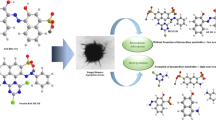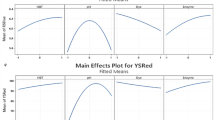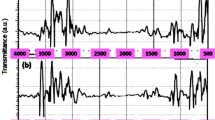Abstract
Many products contain dyes, such as fabrics. However, most of the industry-generated waste is improperly handled, which causes serious environmental problems for the bodies of water that receive textile effluents. This study aimed to analyze the effect of biosorbents and biosorption techniques on decolorizing the textile azo dye Acid Blue 29 in an aqueous solution employing pine sawdust. Pine sawdust is low-cost substrate with minor environmental impact. A toxicity test was performed with Lactuca sativa seeds to determine the LC50 of the dye. Subsequently, a biosorption test was performed to determine the toxicity of the resulting solutions. We observed that biosorption is a very feasible technique for the discoloration of the solutions and promotes reduction in their toxicity.






Similar content being viewed by others
References
Allen, S. J., Mckay, G., & Porter, J. F. (2004). Adsorption isotherm models for basic dye adsorption by peat in single and binary component systems. Journal of Colloid and Interface Science, 280, 322–333.
Almeida, E. J. R., & Corso, C. R. (2014). Comparative study of toxicity of azo dye Procion Red MX-5B following biosorption and biodegradation treatments with the fungi Aspergillus niger and Aspergillus terreus. Chemosphere, 112, 317–322.
Asgher, M., & Bhatti, H. N. (2010). Mechanistic and kinetic evaluation of biosorption of reactive azo dyes by free, immobilized and chemically treated Citrus sinensis waste biomass. Ecological Engineering, 36, 1660–1665.
Corso, C. R., & Almeida, A. C. M. (2009). Bioremediation of dyes in textile effluents by Aspergillus oryzae. Microbial Ecology, 57, 384–390.
Forgacs, E., Cserháti, T., & Oros, G. (2004). Removal of synthetic dyes from wastewaters: a review. Environment International, 30, 953–971.
Gong, R., Ding, Y., Li, M., Yang, C., Liu, H., & Sun, Y. (2005). Utilization of powdered peanut hull as biosorbent for removal of anionic dyes from aqueous solution. Dyes and Pigments, 64, 187–192.
Kimura, I. Y., Gonçalves, A. C., Jr., Stolberg, J., Laranjeira, M. C. M., & Fávere, V. T. (1999). Efeito do pH e do tempo de contato na adsorção de corantes reativos por microesferas de quitosana. Polímeros: Ciência e Tecnologia, 9, 51–57.
Kunz, A., Peralta-Zamora, P., Moraes, S. G., & Durán, N. (2002). Novas tendências no tratamento de efluentes têxteis. Quimica Nova, 25, 78–82.
Kurniawan, A., Sutiono, H., Indraswati, N., & Ismadji, S. (2012). Removal of basic dyes in binary system by adsorption using rarasaponin–bentonite: revisited of extended Langmuir model. Chemical Engineering Journal, 189–190, 264–274.
López, M. J., Guisado, G., Vargas-Garcia, M. C., Suárez-Estrella, F., & Moreno, J. (2006). Decolorization of industrial dyes by ligninolytic microorganism isolated from compositing environment. Enzyme and Microbial Technology, 401, 42–45.
Mitter, E. K., Santos, G. C., Almeida, E. J. R., Morão, L. G., Rodrigues, H. D. P., & Corso, C. R. (2012). Analysis of acid Alizarin Violet N dye removal using sugarcane bagasse as adsorbent. Water, Air, and Soil Pollution, 223, 765–770.
Patil, P., Desai, N., Govindwar, S., Jadhav, J. P., & Bapat, V. (2009). Degradation analysis of Reactive Red 198 by hairy roots of Tagetes patula L. (marigold). Planta, 230, 725–735.
Rahman, A., Urabe, T., & Kishimoto, N. (2013). Color removal of reactive procion dyes by clay adsorbents. Procedia Environmental Sciences, 17, 270–278.
Sobrero, M. S., & Ronco, A. (2008). Ensayo de toxidad aguda con semillas de lechuga Lactuca sativa L. Ensayos toxicológicos pra la evalucion de susbstancias químicas em agua y suelo (Vol. 1, pp. 55–68).
Utomo, H. D., Phoon, R. Y. N., Shen, Z., & Ng, L. H. (2015). Removal of Methylene Blue using chemically modified sugarcane bagasse. Natural Resources, 6, 209–220.
Vitor, V., & Corso, C. R. (2008). Decolorization of textile dye by Candida albicans isolated from industrial effluents. Journal of Industrial Microbiology and Biotechnology, 35, 1353–1357.
Acknowledgments
Support from the Brazilian fostering agencies Pibic/Pibid, FAPESP/Brazil, CAPES/Brazil, CNPq/Brazil, and Fundunesp/Brazil is acknowledged.
Author information
Authors and Affiliations
Corresponding author
Rights and permissions
About this article
Cite this article
Guari, E.B., de Almeida, É.J.R., de Jesus Sutta Martiarena, M. et al. Azo Dye Acid Blue 29: Biosorption and Phytotoxicity Test. Water Air Soil Pollut 226, 361 (2015). https://doi.org/10.1007/s11270-015-2611-3
Received:
Accepted:
Published:
DOI: https://doi.org/10.1007/s11270-015-2611-3




